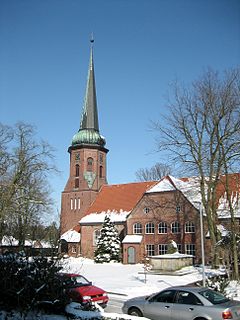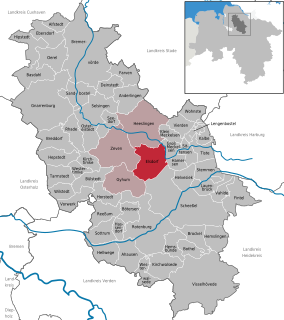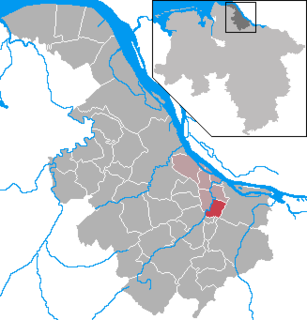
The Prince-Archbishopric of Bremen — not to be confused with the modern Archdiocese of Hamburg, founded in 1994 — was an ecclesiastical principality (787–1566/1648) of the Holy Roman Empire and the Catholic Church that after its definitive secularization in 1648 became the hereditary Duchy of Bremen. The prince-archbishopric, which was under the secular rule of the archbishop, consisted of about a third of the diocesan territory. The city of Bremen was de facto and de jure not part of the prince-archbishopric. Most of the prince-archbishopric lay rather in the area to the north of the city of Bremen, between the Weser and Elbe rivers. Even more confusingly, parts of the prince-archbishopric belonged in religious respect to the neighbouring Diocese of Verden, making up 10% of its diocesan territory.

Himmelpforten is a municipality west of Hamburg (Germany) in the district of Stade in Lower Saxony. It is located on the Horsterbeck creek. Himmelpforten is also part and the seat of the Samtgemeinde Oldendorf-Himmelpforten.

Selsingen is a municipality in the district of Rotenburg, in Lower Saxony, Germany. It is situated approximately 15 kilometres (9.3 mi) southeast of Bremervörde, and 45 kilometres (28 mi) northeast of Bremen, and is twinned with the English village of Sawston in Cambridgeshire.

Sittensen is a municipality in the district of Rotenburg, in Lower Saxony, Germany. It is situated approximately 20 km northeast of Rotenburg, and 45 km southwest of Hamburg.

Flögeln is a village and a former municipality in the district of Cuxhaven, in Lower Saxony, Germany. Since 1 January 2015 it is part of the town Geestland.

Elsdorf is a municipality in the district of Rotenburg, in Lower Saxony, Germany.

Mittelnkirchen is a municipality in the district of Stade, Lower Saxony, Germany.

Neuenkirchen is a municipality in the Altes Land, district of Stade, Lower Saxony, Germany.

Sauensiek is a municipality in the district of Stade, Lower Saxony, Germany.

Rübke (help·info) a village located in the north of Lower Saxony, Germany. Its population is 583 (2016). It consists of two main roads.

Cranz is a quarter in the Harburg borough of Hamburg, Germany. It is on the left bank of the Elbe river and one of the 104 quarters of Hamburg. In 2020 the population was 843.
Valdemar Knudsen was a Danish clergyman and statesman. Valdemar was Bishop of Schleswig from 1188 to 1208, officiated as Steward of the Duchy of Schleswig between 1184 and 1187, and served as Prince-Archbishop of Bremen from 1192 to 1194 and again between 1206 and 1217. He held the latter office on the grounds of the archdiocesan capitular election as archbishop elect and of the royal investiture with the princely regalia, but lacked the papal confirmation.

Francop is a quarter in the Harburg borough of the Free and Hanseatic city of Hamburg in northern Germany. In 2020 the population was 711.
Frederick of Saxe-Lauenburg (1554–1586), was a cathedral canon at Strasbourg Minster, chorbishop at Cologne Cathedral and cathedral provost (Dompropst), a function including the presidency of the chapter, at Bremen Cathedral.

John V of Saxe-Lauenburg was the eldest son of Duke Bernard II of Saxe-Lauenburg and Adelheid of Pomerania-Stolp, daughter of Duke Bogislaus VIII of Pomerania-Stolp. He succeeded his father in 1463 as duke of Saxe-Lauenburg.
Conrad of Vechta was Bishop of Verden (1400–1402/1407), Bishop of Olomouc (1408–1413), Archbishop of Prague (1413–1421), and Master of the Mint (1401–1403) and Chancellor (1405–1412) of the Kingdom of Bohemia.

The Prince-Bishopric of Verden was an ecclesiastical principality of the Holy Roman Empire that was located in what is today the state of Lower Saxony in Germany. Verden had been a diocese of the Catholic Church since the middle of the 8th century. The state was disestablished in 1648. The territory was managed by secular lords on behalf of the Bishop of Verden. As a Prince-Bishopric of the Empire, the territory of the state was not identical with that of the bishopric, but was located within its boundaries and made up about a quarter of the diocesan area. By the terms of the Peace of Westphalia, the Prince-Bishopric was disestablished and a new entity was established, the Duchies of Bremen and Verden.

Henry of Saxe-Lauenburg was a Prince-Archbishop of Bremen, then Prince-Bishop of Osnabrück, then Prince-Bishop of Paderborn.

Saint Mary's Cathedral in Hamburg was the cathedral of the ancient Roman Catholic Archdiocese of Hamburg, which was merged in personal union with the Diocese of Bremen in 847, and later in real union to form the Archdiocese of Hamburg-Bremen, as of 1027.


















